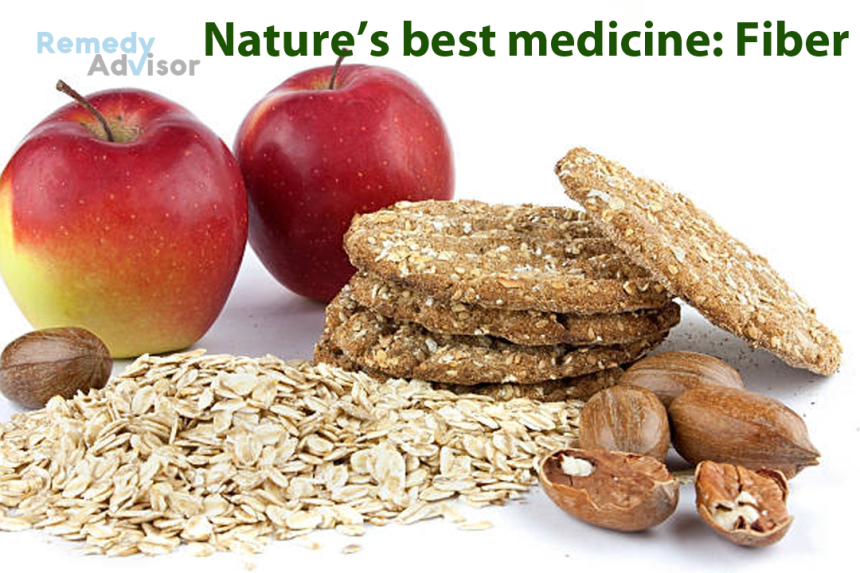Good health grows on trees! It hangs from apple-laden boughs and courses through crinkly spinach leaves. It hides in carrots growing beneath the soil and flows in those amber waves of wheat.
And all of this good health is yours for the picking. Every morsel of food that you get from plants luscious fruits, crisp vegetables, flavorful grains contains fiber. Researchers are finding fiber has remarkable power to preserve your health and prevent disease.
Fiber may help prevent heart disease, diabetes and obesity, research shows. It may even play a role in preventing cancer, some studies suggest. And curing constipation with fiber may be the oldest medical trick in the book.
The many faces of fiber
Fiber is the term for the parts of plants that your body can’t digest. The first step toward using the health power of fiber knows that there are actually several different kinds, each with its own unique ability to keep you well.
There’s cellulose (the most prevalent fiber, the one that made bran famous), hemicellulose and lignin, fibers found in whole grains, fruits, vegetables and beans. There’s pectin, the fiber that puts the gel in jelly. And finally, there are gums, which are sticky fibers you eat without even realizing it. These plant-derived thickening agents are used in foods as different from one another as bologna and ice cream.
One way to keep these entire straight is to think of them as falling into two categories: insoluble, those that do not dissolve in water, and soluble, those that do. The insoluble fibers, cellulose, most kinds of hemicellulose and lignin, are best known for their ability to ease constipation. The soluble fibers, pectin and gums, are making their name as cholesterol and diabetes-fighters.
Lower cholesterol
Water-soluble fibers found abundantly in fruits and vegetables have been shown to lower cholesterol, and that can lower your chances of heart disease.
The fiber called pectin is an old timer in the ranks of cholesterol fighters. As long ago as 1961, a study showed that eating pectin reduced blood cholesterol significantly. No less than 15 studies have confirmed those early results in the years since. Pectin has the much-sought-after ability to lower low-density lipoprotein (LDL) cholesterol, the undesirable kind, without touching high-density lipoprotein (HDL) cholesterol, the kind thought to be beneficial.
Studies have shown that a fiber called guar gum is equally as effective as pectin. And research by the U.S. Department of Agriculture (USDA) is showing that other gums lower cholesterol, too. In one study, Kay Behall, Ph.D., a research nutritionist at the Human Nutrition Research Center, Beltsville, Maryland, investigated the effects of three different gums locust bean gum, karaya gum and carboxy methylcellulose in 12 volunteers.
The results were similar to those seen with pectin. Total cholesterol was lowered significantly in the weeks that the gums were eaten. Levels dropped from an average of 200 (not very high to begin with) to 170. And as with pectin, HDL cholesterol was unaffected.
Oat bran and dried beans are the only good food sources of gum that you can buy at the supermarket right now. The other gums are available only on a commercial basis.
But pectin is readily available in fruits and vegetables. Studies show that the amount necessary to lower cholesterol is 8 to 10 grams a day the amount in four oranges, for example.
Fighting diabetes
Fiber can help control diabetes, and possibly prevent it in the first place. More than 15 studies in the last ten years have shown that pectin flattens the rise in blood glucose following a meal. Less glucose in the blood means less insulin is needed to bring it down.
“It’s my opinion that fiber acts primarily to prevent glucose from entering the bloodstream as rapidly as it would if there were no fiber present,” says Sheldon Reiser, Ph.D.., research biochemist and research leader at the USDA’s Human Nutrition Research Center. “It forms a gel that acts as a ‘diffusion barrier’ in the intestine. The glucose has to go through this additional ‘membrane’ to be absorbed, so it’s slowed down. The glucose level doesn’t rise as fast or as high, and the insulin level doesn’t rise as high.”
Fiber fights fat
Even if you overindulge in high fiber foods, you almost can’t help but lose. Here’s why.
- Most fiber foods are not calorically dense. That means that you can indulge in an orgy of eating fruits and vegetables without getting many calories.
- Fiber foods take up a lot of room. You’ll feel full on fruits and vegetables before you take in a lot of calories.
- Fiber foods sneak calories out of your body. In a study by June Kelsay, Ph.D., a research nutritionist at the Human Nutrition Research Center, men on a high-fiber diet excreted 150 calories more per day than men on a low-fiber diet of equal calories.
A moveable feast
If you have a problem with constipation, adding fiber to your diet will almost certainly help. Study after study has shown that fiber speeds the movement of stool through the intestines. Why? Fiber has the ability to attract and hold on to water. It makes the stool softer and easier for your intestines to move along.
If constipation is a problem for you, look to the insoluble fibers to do the trick: cellulose, hemicellulose and lignin. This means you should eat whole grains, fruits, vegetables and dried beans.
Five easy fibers
Here are some suggestions to help you add more fiber to your meals.
- Think brown when you think of bread. Whole wheat (or other whole grain) bread should be the rule.
- Eat potatoes and other vegetables with their skins.
- Consume vegetables which have edible stems or stalks like broccoli.
- Eat fruits that contain edible seeds, like raspberries, blackberries and strawberries.
- Try brown rice, corn tortillas, bulgur wheat or whole wheat pasta. Whole grain doesn’t have to mean bread or cereal.







